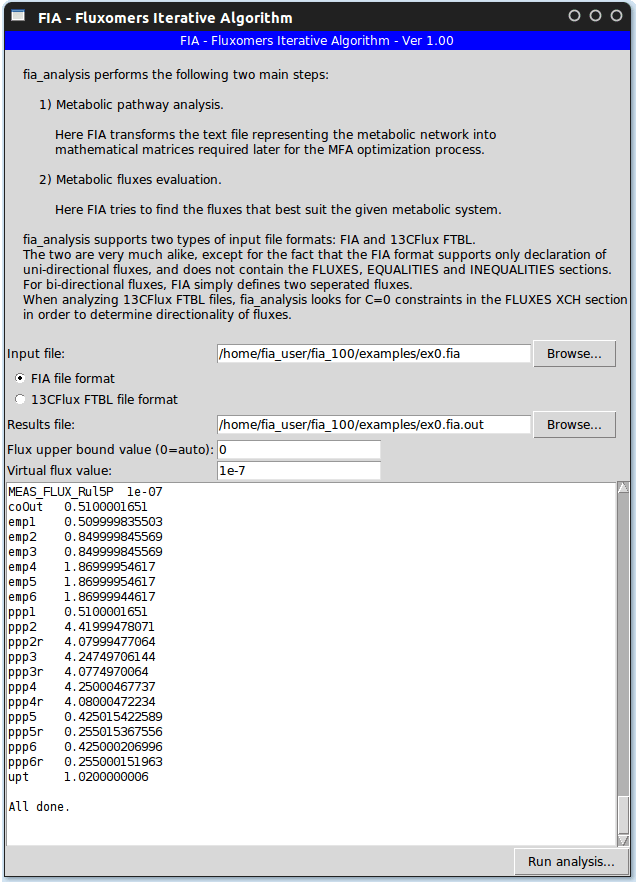FIA - Fluxomer Iterative Algorithm
FIA (Fluxomer Iterative Algorithm) - a new effective method for 13C metabolic fluxes (tracer) experiments analysis
Orr Srour, Jamey D. Young and Yonina C. Eldar
Background
Stoichiometric balance equations are a set of linear constraints representing knowledge of a particular metabolic network structure. Unfortunately, this set of equations is ill-posed, yielding an infinite number of possible values for the metabolic fluxes. In order to fully quantify intracellular metabolic fluxes, various experimental procedures have been developed, exposing hidden features of the metabolic network and thus adding additional equations to the stoichiometric set. One of these methods is 13C metabolic flux analysis (MFA), in which the metabolic pathway is supplied with an isotopically labeled carbon substrate whose influence on the labeling of various metabolite pools within the network is subsequently measured.
Mathematically, these experiments are traditionally analyzed using separate variables representing the fluxes and labeling states of the metabolic system. Analysis of tracer experiments using this set of variables results in a difficult non-convex optimization problem, suffering from both implementation complexity and various convergence issues. In addition, the error model is relaxed in order to ease the optimization process. This relaxation detracts from the statistical quality of the results and, in addition, often necessitates estimation of measurement normalization factors. These considerations render the experimental process and its analysis a very complex (and in some cases impossible) task.
The FIA software addresses the mathematical and computational problems of 13C MFA experiments using a new set of variables referred to as fluxomers. Combining both fluxes and isotopomers, fluxomer variables result in a simply-posed problem with a corrected error model that enables the analysis of incomplete measurement data without the need to estimate additional normalization factors. A simple yet powerful fluxomer iterative algorithm (FIA) is constructed and run in order to solve the MFA optimization problem.

Complete documentation of the algorithm is available in the submitted manuscript:
O. Srour, J. D. Young, Y. C. Eldar, "Fluxomers: A new approach for 13C metabolic flux analysis".
Main Features
- Simple text declaration of the metabolic network and the experimental data (including support for the 13CFLUX FTBL file format).
- NO initial values nor variable types (e.g. free fluxes) are required.
- Supports metabolic fluxes equalities and directionality constraints.
- Supports text based metabolic fluxes formula constraints.
- Supports direct metabolic fluxes value measurements.
- Supports both complete and incomplete measurements of metabolic labels.
- Supports direct use of raw MS measurements data.
Documentation
- Detailed user manual for the FIA software is available in PDF format: download the user manual.
- Detailed source-code documentation is available both online and in PDF format.
Prerequisities
FIA is written in python, and uses the scipy package.
- Python (preferably 2.6), http://www.python.org.
- NumPy from http://www.numpy.org/ or http://www.scipy.org.
- SciPy, http://www.scipy.org.
- UMFPACK, http://www.cise.ufl.edu/research/sparse/umfpack/.
If all prerequisites are met, installing FIA is no more than downloading the source file.
Installing the prerequisites (when necessary) can be sometimes a bit harder.
The easiest approach would be using Ubuntu or other well supported linux distribution.
Note: When maximization of the CPU capabilities is required (for very large simulations or in order to support multiple processors) source compilation of the UMFPACK and ATLAS libraries is highly recommended.
Installing prerequisities under Ubuntu
Installing the prerequisites under Ubuntu (http://www.ubuntu.com) (tested using Ubuntu Desktop version 10.04, but should work with other versions as well) can be done simply by invoking the command:
sudo apt-get install python-scipy python-tk
Installing prerequisities from scratch
- Install Python
- Download from http://www.python.org/.
- Unpack and install Python.
- Install UMFPACK
- Best thing would be installing the binary package for your machine.
- If unavailable, compilation from sources is also possible.
- Download sources from http://www.cise.ufl.edu/research/sparse/umfpack/.
- Follow the author's compilation instructions for the building procedures.
- Install NumPy & SciPy - Scientific Tools for Python
- Download NumPy from http://www.numpy.org/ or http://www.scipy.org.
- Unpack and Install the NumPy package.
- Download sources from http://www.cise.ufl.edu/research/sparse/umfpack/.
- Download Scipy from http://www.scipy.org.
- Unpack and Install the SciPy package. Note the specifications for UMFPACK support.
Downloading the FIA Software
- Version 1RC (along with 11 input example files) is available online under the GNU GPLv3 license: download version 1.00.
- To run FIA software's graphical user interface, simply click the "fia_gui.py" file.
Acknowledgements
This work was done as part of the Masters thesis work of Orr Srour at the Technion, Israel Institute of Technology.

